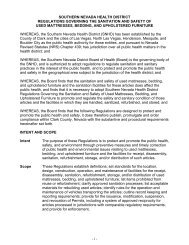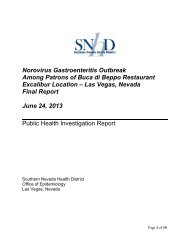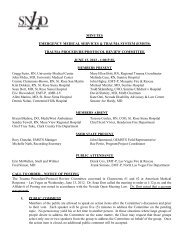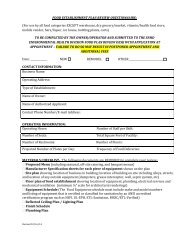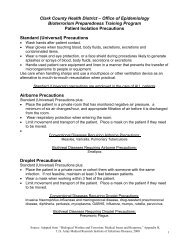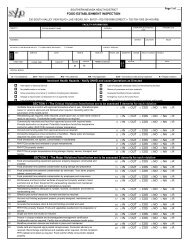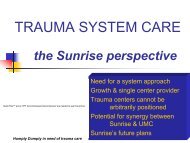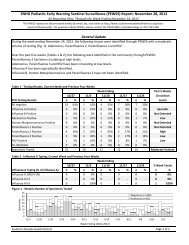Current Trauma Status Report - Southern Nevada Health District
Current Trauma Status Report - Southern Nevada Health District
Current Trauma Status Report - Southern Nevada Health District
Create successful ePaper yourself
Turn your PDF publications into a flip-book with our unique Google optimized e-Paper software.
The trauma system components identified by these documents form the backbone of any quality<br />
trauma system in the country. <strong>Southern</strong> <strong>Nevada</strong> has portions of some of the trauma system<br />
components in place and others that need to be completely addressed.<br />
The following table provides a preliminary indication by The Abaris Group on the current status of<br />
trauma system development in <strong>Southern</strong> <strong>Nevada</strong>. Further refinement to this assessment will be<br />
provided in the final needs assessment report.<br />
Exhibit 1 – <strong>Status</strong> of <strong>Trauma</strong> System Components in <strong>Southern</strong> <strong>Nevada</strong><br />
<strong>Status</strong> of <strong>Trauma</strong> System Components in <strong>Southern</strong> <strong>Nevada</strong><br />
<strong>Trauma</strong> System Component: Definition: In Place Partially Not in Place<br />
Fundamental<br />
Injury Prevention<br />
Prehospital Care<br />
Acute Care Facilities<br />
Rehabilitation<br />
Infrastructure<br />
Leadership<br />
Professional Resources<br />
Education and Advocacy<br />
Information Management<br />
Finances<br />
Research<br />
Technology<br />
Establishing an injury prevention program/coalition that will help<br />
reduce morbidity, mortality and costs associated with trauma.<br />
Addressing issues faced by rural EMS providers (being farther away<br />
from trauma centers and having fewer resources) and urban EMS<br />
provider issues like diversion, triage and ED overcrowding.<br />
Assessing resources in and for trauma centers, establishing<br />
process improvement within the system and making sure adequate<br />
volume is available to maintain trauma center skills.<br />
Helping ensure trauma patients have access to affordable, long<br />
term care.<br />
Establishing an agency that has the authority, responsibility, and<br />
resources to lead the development, operations, and evaluation of a<br />
trauma system in their area.<br />
Addressing shortages in the number of trauma care professionals.<br />
Addressing the education of the public about injury and advocating<br />
for trauma.<br />
Establishing viable databases and information management<br />
systems to be used in assessing a trauma system.<br />
Identifying stable funding sources to ensure a viable, long-term<br />
system.<br />
Identifying a consensus on trauma research priorities.<br />
Continuing to expand the availability of technology used in trauma,<br />
but with an efficient and cost effective focus.<br />
Disaster Preparedness and Response Preparing and coordinating responses to disasters and terrorisms.<br />
Source: <strong>Trauma</strong> System Components as identified by NHTSA, <strong>Trauma</strong> System Agenda for the Future, 2002, with The Abaris Group assessment of status.<br />
X<br />
X<br />
X<br />
X<br />
X<br />
X<br />
X<br />
X<br />
X<br />
X<br />
X<br />
X<br />
Stakeholders during this study were asked which trauma system components were most important.<br />
The top five components by ranking are as follows:<br />
1. Acute care facilities (trauma centers)<br />
2. Professional resources (staffing)<br />
3. Prehospital care<br />
4. Leadership<br />
5. Finances<br />
Page 9



